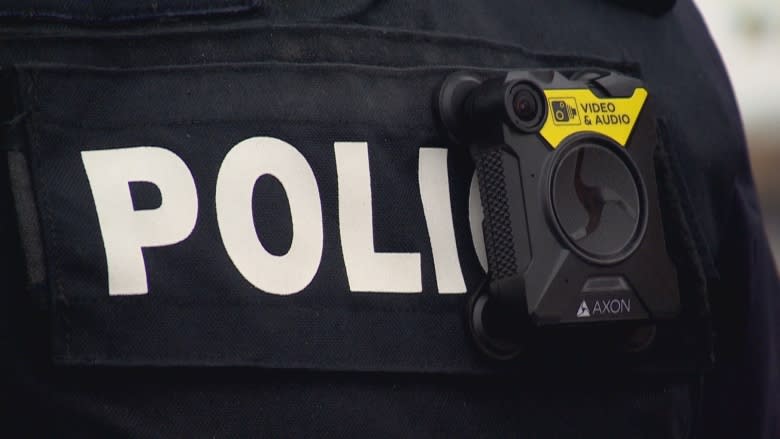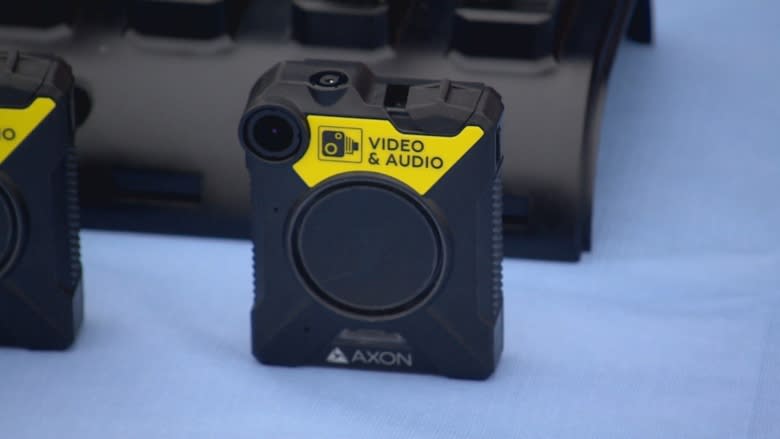Durham police to equip some officers with body-worn cameras, but some advocates are skeptical
Some front-line police officers in Durham Region will soon be outfitted with body-worn cameras while performing regular duties starting this month, but the sister of a man who was fatally shot by Durham police five years ago says she doesn't trust officers to use them.
The initiative launches on June 22 and could see as many as 80 officers deployed with the cellphone-sized devices. It's part of a recommendation that got the green light from the Durham Regional Police Services Board last year.
The $1.2-million project has been four years in the making. Advocates called for the technology to give a clear view of police interactions with the public that can be used as key evidence in trials, especially when there are conflicting accounts of an event. They point to the more than 400 people who have died in confrontations with police across Canada between 2000 and 2017.
"Body-worn cameras have been used around the world to collect evidence for prosecutions, they've been used to improve community trust, police transparency, police legitimacy and procedural justice," said Sgt. Jason Bagg, project manager for Durham Regional Police's body-worn camera project.
"What's not clear is how they will play out in our setting and how much value they will provide to our organization."
But Bagg is optimistic the force will experience similar benefits reported by a growing number of Canadian police services who are testing body-worn cameras. This includes more guilty pleas and higher conviction rates in domestic violence cases, he explained.
The cost of rolling out the pilot project includes training, IT support, video management, evaluation and storage costs, Bagg told CBC Toronto.
The cameras will be attached to the officers when they're on-duty and will record specific police interactions with the public. The officer's full shift will not be recorded, but some critics say this may impact their effectiveness.
It will be up to the officers to decide when to activate the cameras and turn them off.
But Vishal Dhir, managing director in Canada and Latin America for Axon, the camera's manufacturer, explains that the force's training has set out clear guidelines that officers must adhere to.
"Most agencies around the world will leave it to the officer's discretion to turn on and off the camera just because of interactions with their own partners and for tactical situations," he said.
A review of the program held over the last year found that about 83 per cent of the public supports the use of body-worn cameras and about 89 per cent of the public believes it will increase police accountability.
"We're looking at body-worn cameras here in Canada specifically as an evidence gathering tool and how it can help speed up interactions, court dealings, prosecutions for the Crown as well," said Dhir.
But Joanne MacIsaac, who pushed for body-worn cameras after her 47-year-old brother, Michael MacIsaac, was fatally shot by Durham police, is skeptical of the program.
MacIsaac was killed while running naked on an Ajax street, in the midst of what his family called an epilepsy-related psychological episode nearly five years ago.
The officer fired on MacIsaac 12 seconds after stepping out of his cruiser, a coroner's inquest later heard.
Two separate probes by the province's Special Investigations Unit and the Office of the Independent Police Review Director cleared him of any wrongdoing.
While MacIsaac applauded Durham police's steps to improve its policing strategies by increasing transparency between its officers and the community, she told CBC Toronto that body cameras wouldn't have helped in her brother's case.
"The only difference it would have made in Michael's situation is we would actually have some video if the officers chose to turn them on," she said.
As for whether officers will choose to activate their cameras, MacIsaac is doubtful.
"Absolutely, I don't trust them to do that," she said. "Why would they incriminate themselves?"
A recent CBC News investigation uncovered that 461 people have been killed in Canada from 2000 to the end of 2017, as a result of violent encounters with police. Like MacIsaac, 42 per cent of those victims were mentally distressed.
Since 2000, five people have died in fatal encounters with Durham police, according to data compiled by CBC News:
- Gerald Rattu - Jan. 16, 2016
- Michael MacIsaac - Dec. 2, 2013
- Gino Petralia - Nov. 29, 2008
- David Noble - May 11, 2005
- Elyas Bariali - Mar. 6, 2005
As in MacIsaac's case, an officer shot Rattu 52 seconds after the confrontation began. An investigation found that Rattu walked toward the officer while pressing the blade of a butcher knife into his chest. The officer drew his weapon and told Rattu to drop the knife, but he refused and continued to approach. The officer fired his gun, killing Rattu. An SIU investigator said the officer was justified in deploying his weapon.
Durham police join Toronto
Durham police have joined Toronto as the two municipalities in the Greater Toronto and Hamilton area who have outfitted their officers with body-worn cameras.
The Hamilton Police Service has sidelined its body-worn cameras project three times, noting that research doesn't show they're worth the steep costs.
The Toronto Police Service, meanwhile, is taking steps to equip all front-line officers — there are 3,200 in total — with the technology after conducting a similar experiment in 2016.
Earlier this month, the force kicked off the search for a body cameras supplier asking for specific details about the camera's storage and software on a tender website, Merx.
A report following a high-profile pilot project found that although the technology didn't meet officers' complete needs, it did "provide the unbiased, independent account of police/community interactions."
The report pegged the price tag at $85 million over 10 years despite the number of challenges the cameras posed, including technical problems, such as poor battery life and an increased administrative workload.




